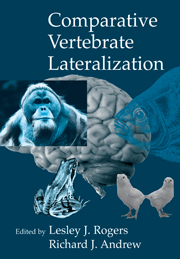Book contents
- Frontmatter
- Contents
- List of Contributors
- Preface
- Introduction
- Part one Evolution of lateralization
- 1 How ancient is brain lateralization?
- 2 The earliest origins and subsequent evolution of lateralization
- 3 The nature of lateralization in tetrapods
- 4 Advantages and disadvantages of lateralization
- Part two Development of lateralization
- Part three Cognition and lateralization
- Part four Lateralization and memory
- Epilogue
- Author Index
- Subject Index
- Richard Andrew
2 - The earliest origins and subsequent evolution of lateralization
Published online by Cambridge University Press: 10 December 2009
- Frontmatter
- Contents
- List of Contributors
- Preface
- Introduction
- Part one Evolution of lateralization
- 1 How ancient is brain lateralization?
- 2 The earliest origins and subsequent evolution of lateralization
- 3 The nature of lateralization in tetrapods
- 4 Advantages and disadvantages of lateralization
- Part two Development of lateralization
- Part three Cognition and lateralization
- Part four Lateralization and memory
- Epilogue
- Author Index
- Subject Index
- Richard Andrew
Summary
Lateralization and predation
Recent studies of cerebral lateralization in teleost fish (Cantalupo, Bisazza and Vallortigara, 1995; Bisazza, Pignatti and Vallortigara, 1997a, 1997b; Miklósi, Andrew and Savage, 1998; Bisazza, Rogers and Vallortigara, 1998; Miklósi and Andrew, 1999; Chapter 1 by Vallortigara and Bisazza) have provided a sketch of the basic properties of early vertebrate lateralization. As a result, it is now possible to think concretely about the even earlier steps in evolution, by which this condition may have originated. Cerebral lateralization in extant fish is likely to have changed less during evolution than in tetrapods because the selection pressures imposed by life in water have remained (to some degree) the same.
The features that seem most likely to have been present very early in vertebrate evolution are the use of the right eye (RE) to fixate objects, (1) which the fish intends to bite or (2) which it is investigating, whilst at the same time inhibiting escape. This is accompanied by use of the left eye (LE) to fixate (3) familiar objects or (4) conspecifics that evoke sexual or social (schooling) behaviour.These features have been found in a number of species from different major taxa: all four are present in Brachydanio rerio (Cypriniformes, Ostariophysii (Miklósi, Andrew and Savage, 1998; Miklósi and Andrew, 1999; Sovrano, pers. comm.), whilst 2 and 4 have been described (Bisazza, De Santi and Vallortigara, 1999; Sovrano et al., 2000) for a number of Poeciliids and other families of the Cyprinodontiformes, which belong to the Acanthopterygii, rather than the Ostariophysii.
- Type
- Chapter
- Information
- Comparative Vertebrate Lateralization , pp. 70 - 93Publisher: Cambridge University PressPrint publication year: 2002
- 25
- Cited by



